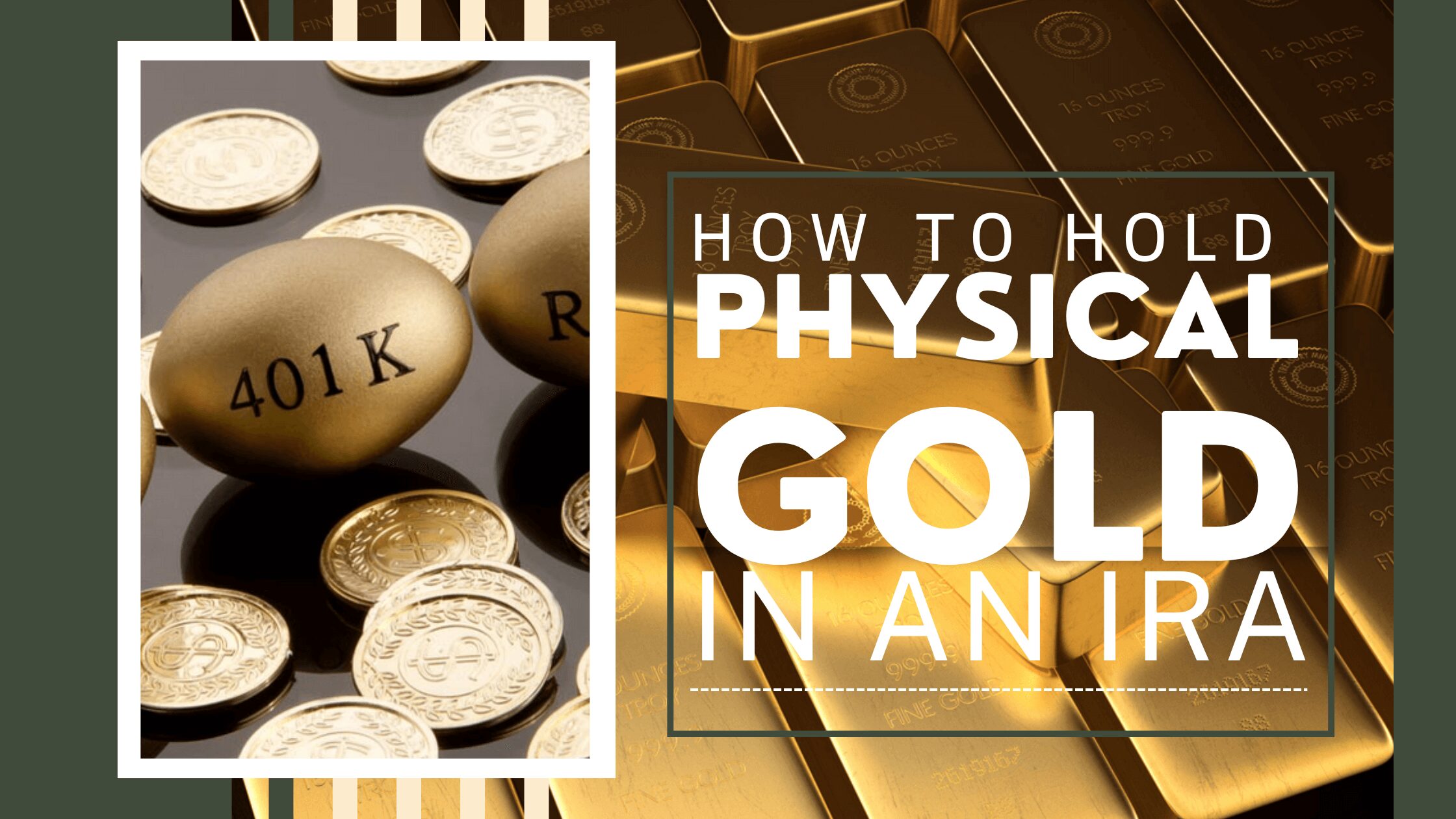Are you looking into how to hold physical gold in an IRA? Then, this guide is for you!
Holding physical gold and silver in an IRA not only creates a hedge against market volatility and inflation but also allows you to enjoy tax-free growth on your money.
This guide will explain how to hold physical gold in an IRA and the benefits and risks involved.
Let’s begin by taking a look at why there’s a rising demand for gold right now and why you should consider diversifying your investment portfolio with a tangible asset.
Important Notice!
Before we get further into this subject, it is vital to note that picking a precious metals IRA provider is a crucial financial choice that will have long-term effects on your financial situation.
Our objective is to give you the most accurate and trustworthy information possible to assist you in choosing the best course of action for growing and safeguarding your money right now.
We have researched and rated the top 7 precious metals IRA companies of 2025 to help make your decision easier!

Market Update: The Rising Demand for Gold as a Retirement Asset
In today’s economic climate, investors are looking for ways to hedge against inflation, economic downturns, and market volatility.
With stock market fluctuations and concerns over the declining purchasing power of fiat currency, many individuals saving for retirement are turning to physical gold and silver to secure and protect their savings.
Gold has historically served as a safe-haven asset, maintaining its value over time and acting as a hedge against inflation and economic instability.
In times of recession, geopolitical tension, and currency devaluation, gold prices tend to rise as investors seek stability. As of recent market trends, gold has been hovering near record highs, demonstrating its resilience amid economic uncertainty.
For those planning their retirement, adding physical gold to an Individual Retirement Account (IRA) provides a strategic way to diversify a portfolio, mitigate risk, and protect wealth for the long term.
“Adding gold to your portfolio could reduce risk and enhance returns as we approach a “paradigm shift,” Bridgewater chief Ray Dalio.
In this video, we’ll share why Ray Dalio and Sam Zell, founder of Equity Group Investments, invest in gold to protect their wealth:
Why Hold Physical Gold in an IRA?
 A gold IRA allows investors to own physical gold while enjoying the tax benefits of an IRA. This type of self-directed IRA lets you invest in gold, silver, platinum, and palladium rather than traditional stocks and bonds.
A gold IRA allows investors to own physical gold while enjoying the tax benefits of an IRA. This type of self-directed IRA lets you invest in gold, silver, platinum, and palladium rather than traditional stocks and bonds.
Here are some key benefits:
- Hedge Against Inflation: Gold has historically retained its purchasing power and value over time, making it an excellent hedge against inflation.
- Portfolio Diversification: Holding gold within an IRA helps reduce risk by diversifying investments beyond stocks and bonds.
- Protection Against Economic Downturns: Gold’s value often rises during periods of financial crisis, providing stability to a retirement portfolio.
- Long-Term Wealth Preservation: Gold’s scarcity and demand make it an asset that can preserve wealth over generations.
- Tax-Deffered Growth: A gold IRA provides valuable tax advantages, as the IRS permits specific types of gold investments to be included in retirement accounts. In essence, it lets you leverage a legal IRS loophole to hold physical gold and silver within your existing retirement savings—without incurring taxes or penalties.
As you can see, holding physical gold in an IRA comes with many advantages that are essential in times of market uncertainty.
>>>Request this FREE Gold & Silver Guide to learn more about holding physical gold in an IRA
Get up to $10,000 in FREE Silver
Let’s now explore the different types of IRAs and how to roll over your existing retirement account into a gold IRA.
Understanding a Gold IRA Rollover
A gold IRA rollover allows investors to transfer funds from an existing retirement account—such as a Traditional IRA, Roth IRA, 401(k), or 403(b)—into a self-directed IRA that holds physical gold and other precious metals.
This process involves moving assets without incurring tax penalties, provided the rollover follows IRS guidelines.
Direct vs Indirect Gold IRA Rollovers
When rolling over funds from a 401(k) to a Gold IRA, there are two primary methods:
- Direct Rollover (Trustee-to-Trustee)
- Indirect Rollover (Trustee-to-Client-to-Trustee)
Let’s break down the differences between these two options.
Direct Rollover: The Simplest and Most Secure Option
A direct rollover is the most straightforward and IRS-preferred method for transferring funds from a 401(k) to a gold IRA.
With this approach, your retirement funds move directly from your current 401(k) custodian to your new gold IRA custodian—without ever passing through your personal account.
How it works:
- – Once you set up your gold IRA, you’ll coordinate with your current 401(k) plan administrator to initiate the rollover
- – Your new gold IRA custodian will provide instructions to ensure a seamless transfer
- – The IRS will issue Form 1099-R, which records the transaction. The key detail to note is box 7, which will have the distribution code “H”—signifying that this is a tax-free rollover.
Because the funds are never in your personal possession, there is no tax withholding, and you avoid potential IRS penalties.
If you’re ready to take action
Indirect Rollover: More Flexibility, But With Risks
An indirect rollover allows you to move funds from your 401(k) to a gold IRA but with an added step: the money is first sent to you before being deposited into your new retirement account.
How it works:
- – Your 401(k) plan administrator issues you a check for the amount you wish to transfer
- – To keep the transaction tax-free, you must deposit the full amount into your gold IRA within 60 days
- – The IRS requires your plan administrator to withhold 20% of the distribution for taxes, which means you’ll initially receive only 80% of your total balance
- – If you wish to maintain the tax-advantaged status of your full rollover, you’ll need to personally contribute the withheld 20% from other funds when depositing into your new gold IRA
- – If you fail to complete the deposit within 60 days, the IRS considers the distribution taxable, potentially triggering income taxes and early withdrawal penalties (if you’re under 59½)
Key Considerations:
- – Indirect rollovers offer flexibility, but they come with more administrative work and the risk of missing the 60-day deadline
- – If you don’t replace the withheld 20%, you may owe taxes on that amount
- – The IRS generally limits indirect rollovers to one per 12-month period, unlike direct rollovers, which have no restrictions
With this information in mind, let’s take a look at the difference between a Traditional IRA and a Roth IRA.
Get up to $10,000 in FREE Silver
Traditional IRA vs Roth IRA: Which One Is Right for Gold and Silver Investment?
When setting up a gold IRA, investors must choose between a Traditional IRA and a Roth IRA.
Here’s how they differ:
Traditional IRA
Here’s a summary of a Traditional IRA:
- Tax Advantages: Contributions are tax-deductible, reducing taxable income in the contribution year
- Tax Treatment: Taxes are deferred until withdrawals begin in retirement
- Required Minimum Distributions (RMDs): Account holders must start taking distributions at age 73
- Best For: Individuals who expect to be in a lower tax bracket in retirement
Roth IRA
In contrast to a Traditional IRA, a Roth IRS entails:
- Tax Advantages: Contributions are made with after-tax dollars, meaning withdrawals are tax-free in retirement
- Tax Treatment: Since contributions are not tax-deductible, all growth and qualified withdrawals are tax-free
- No RMDs: Unlike a Traditional IRA, Roth IRAs do not require mandatory distributions at any age
- Best For: Investors who expect to be in a higher tax bracket in retirement and prefer tax-free withdrawals
Choosing between a Traditional and Roth IRA ultimately depends on your current financial situation and future tax expectations, making it important to align your decision with your long-term retirement goals.
IRS Rules and Guidelines for Gold IRAs
The IRS has strict regulations regarding which types of gold can be held in an IRA. Some key requirements include:
- Purity Standards: Gold must be at least 99.5% pure to qualify for an IRA
- Approved Coins and Bars: Eligible gold products include the American Gold Eagle, Canadian Gold Maple Leaf, and certain gold bars from approved refiners
- Storage Requirements: Gold must be stored in an IRS-approved depository; home storage is not allowed for IRA-held gold
Understanding and adhering to these IRS rules is essential to ensure your gold IRA remains compliant and retains its tax-advantaged status.
With this in mind, let’s show you how to start a gold IRA.
How to Start a Gold IRA
Starting a gold IRA is a quick and easy process. Here’s the typical process:
- Step 1: To get started, request this FREE Gold IRA Guide from our #1 recommendation for gold IRA company a and learn how to best invest in precious metals.
- Step 2: You will be contacted by a precious metals specialist to ask questions in the following stage.
- Step 3: If you decide to proceed, you will then contact with an IRA Specialist who will inquire about your present retirement account and assist in determining your eligibility for a rollover.
- Step 4: Additionally, if you are qualified to convert your current retirement assets into a gold IRA, you must open an account with a custodian qualified to manage self-directed IRAs.
- Step 5: You will transfer money from your current retirement account to a new Self-Directed IRA whenever the necessary documentation is completed.
- Step 6: Now is the time to buy your precious metals.
Let’s now take a look at what to consider when choosing an IRA custodian.
How to Find a Reliable Gold IRA Custodian
Selecting the right custodian or gold IRA company is crucial for a successful gold IRA. Key factors to consider when choosing a provider include:
- Reputation and Reviews: Look for custodians/gold IRA companies with positive customer feedback and preferably an A+ BBB rating
- Fee Transparency: Understand the custodian’s fees, including account setup, storage, and annual maintenance
- Customer Service: Ensure the company provides excellent lifetime support for account management
- Compliance and Accreditation: Choose a custodian that complies with IRS and industry regulations
To make your research and vetting process easier, we have reviewed and rated the 6 best gold IRA companies for 2025:
1. Goldco: Best Gold IRA Provider Overall
2. Birch Gold Group: The Gold IRA Specialist
3. Golden Crest Metals: Best For Integrity & Trust
4. Noble Gold: Most Personalized Service
If you’re ready to take action
Holding Physical Gold in an IRA FAQ
Is a gold IRA safe?
Yes! As long as you choose a reputable firm for your investment, a gold IRA is safe and can help protect your savings from market volatility, inflation, and geopolitical instability. Owning gold and other precious metals is a store of value.
Can I take physical possession of gold in my IRA?
Yes! You can take physical possession of the gold in your IRA after the age of 59 ½ without risking any tax penalties.
What Is the difference between a Traditional IRA and a gold IRA?
While gold IRAs allow you to own physical precious metals such as gold, silver, platinum, and palladium, traditional IRAs often invest in equities, bonds, and mutual funds.
What if I don’t want physical precious metals in my IRA?
You may benefit from the rise in gold prices without having to worry about storing and protecting physical gold if you choose to invest in gold mining equities rather than physical precious metals. Purchasing exchange-traded funds (ETFs) that follow the price of gold is an additional choice.
What are the benefits of investing in gold through a gold IRA?
To begin with, gold has a proven track record of retaining its value over time, serving as a tangible asset that acts as a safeguard against inflation and economic instability. It serves as a reliable means of preserving your wealth during periods of financial turbulence.
Furthermore, opting for gold investments within an IRA provides notable tax benefits. These advantages encompass tax-deferred growth, as well as the option to make penalty-free withdrawals after reaching the age of 59 ½.
What are the IRS rules for precious metals IRA?
The IRS has specific standards of purity so your precious metals have to meet these standards:
- Gold must be 99.5% pure
- Silver must be 99.9% pure
- Platinum must be 99.95% pure
- Palladium must be 99.95% pure
What types of retirement accounts can be transferred to a gold IRA?
You have the flexibility to transfer various types of retirement accounts into a gold IRA, provided that the account custodian or trustee permits such transfers. Here’s a comprehensive list of transferable retirement accounts:
- Employer-sponsored 401(k)
- Self-directed 401(k)
- Traditional IRA
- Roth IRA
- TSP (Thrift Savings Plan)
- 403(b)
- 457(b)
- SEP IRA
This broad range of transferable retirement accounts allows individuals to explore the option of converting their existing retirement assets into a gold IRA, should they choose to do so.
How much does a gold IRA cost?
The cost of a gold IRA varies based on the provider and account type. Expect fees for setup, maintenance, and gold purchases. Custodians typically charge a one-time setup fee (around $80), a wire transfer fee ($30), and an annual maintenance fee ($100).
Storage is another key expense. Home storage isn’t recommended—IRS-compliant depositories like the Delaware Depository offer segregated storage for $150 per year or non-segregated for $100. Overall, annual costs range from $180 to $350.
Where should I store my gold IRA?
IRS rules require IRA-held gold to be stored in an approved depository—not at home. Trusted options include Brink’s, the Delaware Depository, and IDS, ensuring secure and compliant storage. Most gold IRA providers work with vetted custodians to manage this process.
Are there any penalties for moving my IRA or 401(k)?
No, if done following IRS requirements, a gold IRA rollover is a tax-free procedure with no costs or penalties. As long as the money is transferred to a new IRA within 60 days, money taken out of an IRA is not subject to penalties or taxes.
Conclusion: Is a Gold IRA Right for You?
Holding physical gold in an IRA can be a powerful way to secure your retirement savings, hedge against inflation, and diversify your investment portfolio. By understanding the rules and processes involved, you can make an informed decision about whether a gold IRA aligns with your financial goals.
Before making any investment decisions, consult with a financial advisor or tax professional to determine if a gold IRA fits within your overall retirement strategy. With careful planning, a gold IRA can serve as a valuable component of a well-rounded retirement portfolio.
>>>Request this FREE Gold & Silver Guide to learn more about holding physical gold in an IRA
For more information about gold IRAs, you can visit these related resources:






















